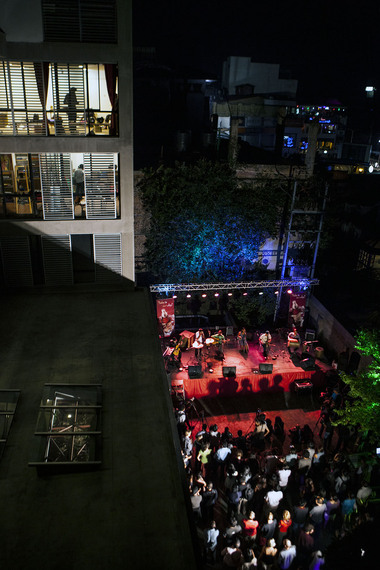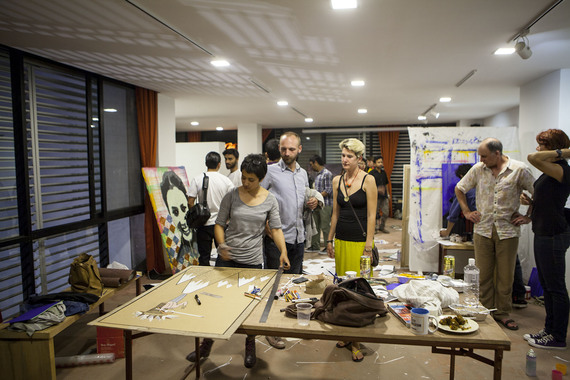On a perfect spring evening The City Museum of Kathmandu, led by its director Kashish Das Shrestha, hosted a crowd of nearly 200 for a unique event titled Khumbila. The event was a fundraiser for the families of the Sherpas who perished at Mount Everest in mid-April, but it encompassed more than what it intended. It shone a spotlight on Kathmandu's new microcosm, a crowd largely composed of twenty- and thirty-somethings: artists, musicians, writers, bloggers, entrepreneurs, innovators and creators, most of whom have lived or studied abroad and have now returned to their homeland, eager, energized and excited.
The concert at the parking lot featured an impressive line-up of diverse musicians. While Rahul Giri opened the show by giving us a taste of his Bangalore based downtempo/electronica band Sulk Station, local favorite Kutumba marked its tenth anniversary by playing some of its popular tunes. There were also performances by Night, Aaveg, the all girls folk ensemble Shree Tara and the double grammy-nominated British artist Jamie Catto.
What elevated the evening and made it truly interdisciplinary was the live art taking place at the museum's third floor. As the music played on, guests walked upstairs and mingled with artists from Artudio and Artlab who were focused on their craft. Some visitors chose to stand in a corner, merely observing and witnessing this creative process, while others interacted and questioned. I was particularly intrigued by Shraddha Shrestha's work. She used rulers, markers, paper cut-outs and a rectangular cardboard piece that showcased a young man on top of a mountain. Inside the mountain range were numerous bodies piled on top of each other.
"We usually tend to glorify people who succeed but forget the ones who have been part of the success," said Shraddha when asked about her work, alluding to all the climbers who reach the summit and the porters usually left out of the limelight. Shraddha's piece was fitting for the event but I connected with it on a more personal level. I thought of my own journey - recently back from the United States after spending more than a decade there - and all the people who have helped me stand up until now. The dude in Shraddha's art was, in a way, a version of myself.
What does it mean to be successful? This new crop of youths, after exploring individual educational pathways, are coming up with their own answers. Following their heart's desires - something that rarely happened in Nepal before - this courageous generation is modeling new lifestyles, occupations and mindsets for its younger counterpart.
The older folks are gradually getting less baffled and more welcoming. They also may not have a choice. After witnessing Nepal's stagnation for over two decades and bidding farewell to children who left the country en masse to never return, they are now releasing a deep sigh of relief. "It's great to see well-informed young people finally taking leadership," said Ela Piya, founder of Kasthamandup Vidyalaya at the closing seminar of the groundbreaking Climate + Change exhibition at Nepal Art Council.
The four month long exhibition was a project coordinated by another young visionary, NayanTara Gurung Kakshapati, who founded Photo.Circle a few years ago. Feeling the need to educate more than anything else, NayanTara brought together an avid arts educator, Sharareh Bajracharya from Srijanalaya, and myself to design and manage the exhibition's Arts and Education program. The closing seminar was our way of sending a message to Nepal's school leaders, teachers and policy makers that we need to urgently rethink what it means to educate and reimagine school curricula. In other words, we all need to come together to redefine success. Young thought leaders like Sneha Shrestha who is starting Nepal's first children's art museum and Ayushma Regmi from Nisarga Bal Batika also voiced revolutionary pedagogical ideas at the seminar.
The emphasis has to shift from disconnected textbook teaching to meaningful project-based learning. Students need to be pushed to read, write and think for themselves, to imagine possibilities that older generations couldn't. We all need to engage in critical conversations and help younger students develop habits of minds that will help them create and forge new paths for themselves. Ultimately, we all need to positively influence the diverse communities of our nation.
Fortunately, some of this work has already started. While Dr.Shanta Dixit and Ms.Milan Dixit pioneered progressive education in Nepal by founding Rato Bangla School, Ms. Piya, who worked at Rato Bangla, started her own school at the other end of the city in order to continue this important work. On the other hand, the founding directors of Triyog School, Ms. Usha Basnyat, Ms. Rupa Thapa and Dr. Shanti Basnyat, are actively reaching out and seeking help to revamp their school curricula and restructure age-old systems. Similarly, the administration of Thames College is also interested in providing more academic rigor to its students and diversifying their programs by including liberal arts courses. Apart from working with some of these schools, I have also started collaborations with Suvani Singh and Pranab Man Singh who manage the Book Bus that travels to government schools inside and outside the valley, conducting literacy, art and library development workshops.
The City Museum of Kathmandu, which opened to the public only this week, promises to be a place for infinite possibilities. Even its walls and ceilings, high and contemporary, stand apart from Nepal's traditional narrow rooms. There is a sense that the physical wants to scaffold the mental, to open things up, to offer more light and air. To provide more space.
But there are challenges. Kutumba may have the skills, but their critics complain that they haven't grown as artists, perhaps because of a lack of competition or market demand. Due to its smallness, it is easy to feel claustrophobic and under-appreciated in Nepal. This is a sentiment shared by Prawin Adhikari and Rabi Thapa, two of the editors of Lalit magazine, both of whom have published a collection of short stories written in English and who were both present at Khumbila. A few other English language books written by Nepalis is coming out later this year: Aditya Adhikari's history of the civil war, Manjushree Thapa's next novel and Prashant Jha's personal account of Nepal's political transition will not only enhance and stretch the imaginations of Nepalis all over the world but will contribute to an ongoing process of redefining and articulating a national identity. In addition, Thomas Bell's socio-political narrative Kathmandu will hopefully deepen the international community's understanding of Nepal's complex and multilayered society and politics. All of these writers are focused and fueled by their passions, even though readership amongst Nepalis, especially when it comes to English literature, is still very low.
Is this an era that is meant to last and will bring sweeping changes in Nepal or is this an ephemeral bubble? Was Khumbila a Kathmandu-centric event meant for its small pocket of privileged residents or will an event like this help inspire and include our citizens outside the valley? Will the students of schools like Rato Bangla, Kasthamandup and Triyog grow up and participate in conversations with leaders like Rahul, NayanTara and Kashish, forge intergenerational partnerships, and open doors for the less-privileged citizens of our country or will they also eventually head westwards like so many of their uncles and aunts? One has to wait and see.
Meanwhile, in between writing breaks, I contemplated how to spend a Friday evening: whether to watch Eelum Dixit's directorial debut Red Monsoon on its first day of release or go to House of Music for its regular weekly concert. The movie could wait. I met friends and bobbed my head while the Swedish dream pop trio Potiljonen sang "Plastic Panorama".


